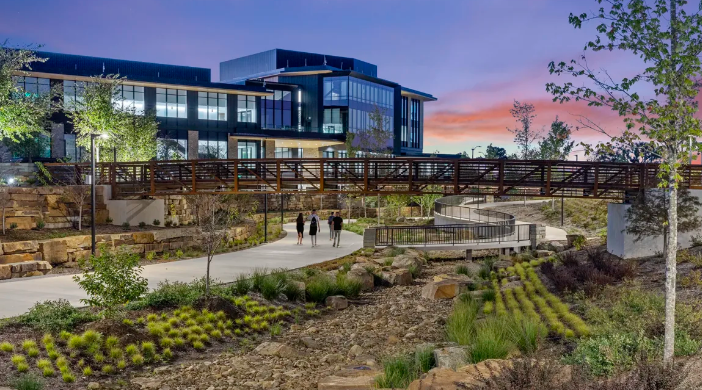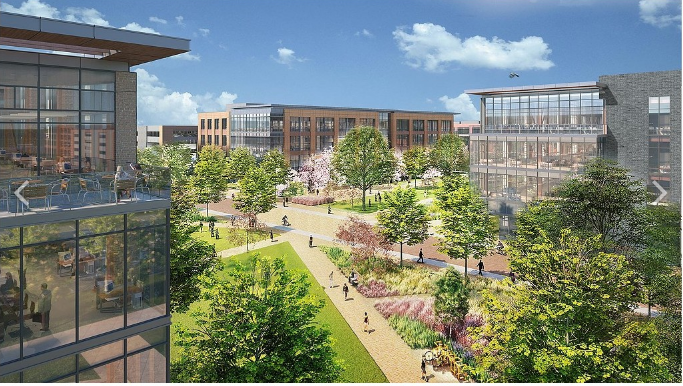
A 350-acre setting for Walmart¡¯s new headquarters is under
construction in northwest Arkansas with a sustainable design
plan by a Houston architect featuring office buildings with mass
timber elements regionally produced from Southern yellow pine.
The retailer¡¯s new home office campus in Bentonville, Ark., will
replace the company¡¯s 20 properties scattered in the area.
The 25-building development for 15,000 workers will incorporate
office, retail and a hotel, as well as parking structures,
fitness center, amphitheater, childcare facilities ¡ª and a lake.
About half of the project acreage is slated for green space,
with seven miles of hike and bike trails, including elements of
the Razorback Regional Greenway.
In addition to embracing its natural setting and integrating
public access for its adjacent community, the park-like project
is currently the largest mass timber application in the U.S.
It¡¯s expected to use 1.7 million cubic feet of the engineered
building material, noted for its sustainability as well as its
aesthetics.
Gensler Houston¡¯s Raffael Scasserra: Timber Produces Remarkable
Workplace Environments
As executive architect on the project, Gensler¡¯s Houston office
is at the design helm of the overall project, which the client
calls its ¡°home office¡± rather than ¡°campus.¡±
Gensler is also the design architect for the development¡¯s 12
office buildings, which are slated to open at the pace of one a
month through January 2026. Each one, four or five stories and
flooded with natural light, has its own design personality, but
all have a modular presence and mass timber interiors.

Gensler, a global architecture, design, and planning firm, is no
stranger to mass timber¡¯s applications. Its first such project
in Texas was First United Bank in Fredericksburg in 2018, and
the firm has continued to grow its expertise and project scale.
Gensler Houston principal Raffael Scasserra is design director
of Walmart¡¯s home office project.
He said the design process worked ¡°from the inside out,¡±
considering building functions both shared and unique. The
site¡¯s topography undulates, creating interesting sight lines
and influencing building and amenity placements.
The design team also responded to how the client sought to
better connect its workforce (called ¡°associates¡±) for
collaboration, to honor its heritage and presence in northwest
Arkansas, and to follow design practices that incorporate
sustainability and smart technology.
In support of the latter, using cross-grain mass timber for the
building interiors was a deliberate choice. Lighter than steel,
the renewable material¡¯s properties include carbon reduction,
fire resistance, strength, insulation, and use in biophilic
design. That concept connects workers to the natural world for a
healthier, more tranquil workplace.
¡°The environments it (mass timber) creates are remarkable,¡±
Scasserra said.
As a design challenge, mass timber requires complex
collaboration and coordination at the front end of a project
between its planning, engineering, construction and operations
teams. This is because each building¡¯s mass timber kit is
fabricated off-site. Its pieces are numbered for specific
installation based on precise measurements for proper alignment
of, for example, mechanicals.
Of note on the Walmart project is that much of the mass timber
to be used is regionally produced from Southern yellow pine.
Source:
realtynewsreport.com